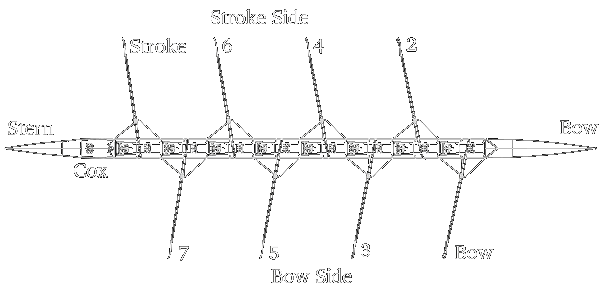Rowing
A Guide to Coxing
Introduction to the sport
Rowing takes place in thin boats made of either wood or synthetic materials.
The front of the boat is called the bow. The back is called the stern. Looking at the boat from stern to bow, the left-hand side of the boat is called strokeside and the right-hand side of the boat is called bowside.
Boats seat between 1 and 8 rowers (or oarsmen) who face backwards and might also include a seat for a cox who faces forwards. Depending on the size and make of the boat, the cox may either be at the front of the boat, in which case the boat is called a front-loader, or he may be at the stern of the boat, in which case the boat is called a stern-loader.
Technically, "rowing" involves each oarsman using only one oar (or blade). If the oarsmen are each using two oars then they are "sculling".
The following table classifies the different boats giving the name of each boat and the symbol which will frequently be used as a convenient abbreviation:
| Rowing | Sculling | ||||
|---|---|---|---|---|---|
| Number of Rowers | Cox? | Name | Symbol | Name | Symbol |
| 8 | Y | Eight | VIII+,8+ | Octuple | 8x+ |
| 4 | Y | Coxed four | IV+, 4+ | Coxed quad | 4x+ |
| 4 | N | Coxless four | IV-, 4- | Coxless quad | 4x- |
| 2 | Y | Coxed pair | 2+ | N/A | |
| 2 | N | Coxless pair | 2- | Double | 2x- |
| 1 | N | Single | 1x- | ||
Octuples and coxed quads are used only by children so you are unlikely to encounter them on the Cam.
The rowers are each assigned a number. The numbering starts at 1 with the rower nearest the bow and continues in order. However, there are two exceptions. The rower nearest the bow is always called "bow" and the rower nearest the stern is always called "stroke". The cox is always simply called "cox".
Conventionally, stroke's oar is on strokeside and the sides alternate as you go down the boat. A rower is considered to be on the side where his oar is attached. This puts stroke, 6, 4 and 2 on strokeside and 7, 5, 3 and bow on bowside (see following diagram).
 |
||
The arrangement of the oars is know as the "rigging". Sometimes the boat will be rigged differently, however stroke & 7 will always be on opposite sides, as will 6 & 5, 4 & 3 and 2 & Bow. The most common alternative rigging is called "bow-rigging" and has each oarsman on the opposite side to usual. It is important to note that strokeside always refers to the left-hand side of the boat as seen by the cox even if stroke's blade is on the right-hand side. Thus stroke is sometimes on bowside and indeed bow is sometimes on strokeside.
Sometimes you will want to refer to more than one oarsman at once. This can be done by listing the numbers of the oarsman to whom you are about to give an instruction but is often better achieved by using a standard abbreviation. The following abbreviations are often used in VIIIs:
- Stern pair - Stroke & 7
- Bow pair - 2 & Bow
- Stern four - Stroke, 7, 6 & 5
- Bow four - 4, 3, 2 & Bow
- Middle four - 6, 5, 4 & 3
- Outside four - Stroke, 7, 2 & Bow
- Strokeside -usually Stroke, 6, 4 & 2
- Bowside - usually 7, 5, 3 & Bow
It will be helpful reading this guide to be familiar with a few terms:
"Backstops" is the position when the legs are straight, the arms are up against the body, and the blade leaves the water. The moment when the blade leaves the water is called the "finish". "Frontstops" is the fully compressed position when the legs are bent, the arms are outstretched, and the blade enters the water. The moment when the blade enters the water is called the "catch".
The "drive phase" is the half of the stroke in which the rower moves from frontstops to backstops applying effort to move the boat. "Pressure" refers to the amount of effort being put in. The "recovery" is the half of the stroke in which the rower moves forwards from backstops to frontstops in order to take another stroke.
When the blade is out of the water and perpendicular to the water's surface it is said to be "square"; when it is out of the water and parallel to the water's surface it is said to be "feathered". Paddling with "feathered blades" means that on the recovery the blades are all feathered. This is the normal state of affairs and it will be assumed that this is what you mean unless you state otherwise. Paddling with "square blades" means that on the recovery the blades should all be square.
|
|
||||||||||||||||||||||||||||||||
In addition to the above, more information on rowing terms can be found in the 'Jargon' section.







